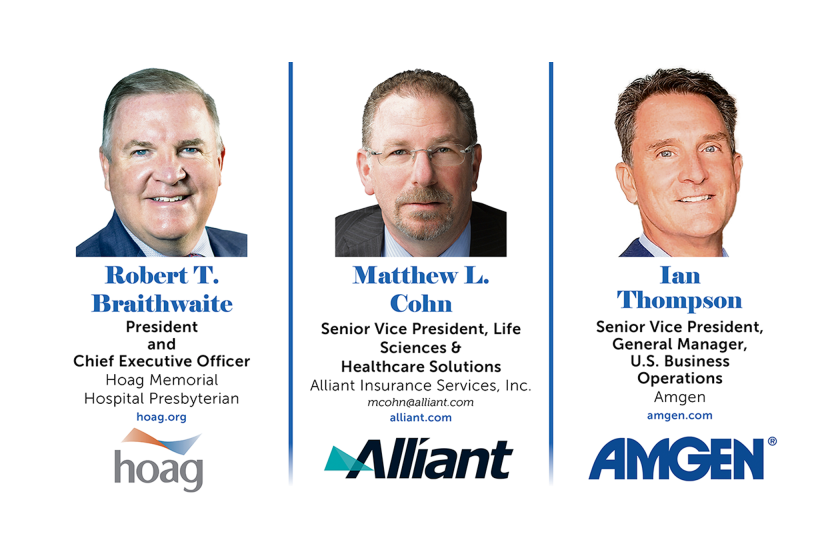Robert T. Braithwaite Shares Insights on the State of Healthcare, Biotech & Life Sciences
- Share via
The Healthcare, Biotech & Life Sciences Q&A is produced by the L.A. Times B2B Publishing team in conjunction with Hoag Memorial Hospital Presbyterian.
The healthcare business sector has been forced to reassess, restructure and remodel itself to accommodate the unpredictable times we have faced over the last few years due to unprecedented changes and challenges. And decision-makers in the healthcare, biotech and life sciences space continue to be faced with a number of challenging questions. Are the advancements that came about due to necessity during the pandemic here to stay? And what about telemedicine and how it has changed the treatment landscape? What other technological innovations are on the horizon?
To take a closer look at the latest trends and modalities in the business of healthcare, biotech and life sciences, we have turned to Robert T. Braithwaite, president and CEO of Hoag Memorial Hospital Presbyterian, who graciously weighed in for a discussion and shared insights on the state of healthcare in 2023.
Q: What are some of the most exciting innovations you are seeing in the health sector today?
Technological advancements are unquestionably revolutionizing the way health care is delivered. At Hoag, we offer patients access to innovative tools, technology and treatment options that are allowing physicians to detect cancer at the earliest possible stage, develop 3D models with high-resolution images, and create personalized treatment plans that are more targeted and precise than ever before. Hoag is the first hospital on the West Coast to offer the VECTRA WB360 whole-body 3D imaging system, which represents the future of skin cancer early detection and prevention. Another exciting innovation in imaging is the cutting-edge EOSedge System, which provides lightning-fast, high-quality images for musculoskeletal conditions allowing physicians to make well-informed diagnoses and develop personalized treatment plans.
Q: How are today’s technological advances being leveraged to improve the health and well-being of patients?
Hoag is advancing technologies to improve the lives of patients every day. By leading the nation in the use of virtual reality for surgery, pain management and maternal care, our physicians are immersing patients in their own wellness journey. For example, Hoag’s surgeons are among only a few in the nation to use 4D modeling and VR tools to “rehearse” complex procedures, which reduces the time and risk associated with surgery. We are also using VR to help our patients recover faster and experience relief on their healing journey. From managing pain to promoting better sleep, virtual reality is improving our patients’ quality of life. We’ve pioneered these remarkable technologies since 2015 and believe their role in healthcare delivery and patient care will only grow more prominent in the years ahead.
“Technological advancements are unquestionably revolutionizing the way health care is delivered.”
— Robert T. Braithwaite
Q: How will virtual care and/or telemedicine affect the healthcare landscape moving forward?
Beyond virtual and telemedicine health care, Hoag is leading a national movement that will bring health care directly into people’s homes. Studies have shown that patients often recover faster from injury or surgery at home, surrounded by family and in the comfort of their home. Through Hoag at Home, medical and support services are brought to the patient and each patient receives an individual care plan to meet their specific goals and needs. Patients want convenience and we can provide the quality, compassionate care you expect from Hoag seamlessly and in the comfort of your home.
Q: Looking to the future, what health-related trends do you think we can expect to come along within the next five years?
We continue to look for and implement new ways to bring high-quality care directly to the communities we serve. There are only a handful of hospitals like Hoag that combine a personalized, community-based approach with cutting-edge medicine, renowned specialists and access to clinical trials. This “privademic” approach gives us the best of both worlds – the agility and personalized approach of a private, nonprofit hospital paired with the world-class innovations of an academic institution. In the next five years, I think this approach will fuel our ability to identify and meet the evolving needs of our community quickly and effectively. We will better be able to draw on our strengths: speed, flexibility, creativity and evidenced-based innovation. This also allows us to recruit top-ranked physicians across Hoag’s specialized services in areas including cancer, neurosciences, heart and vascular, digestive health, spine and women’s health.

